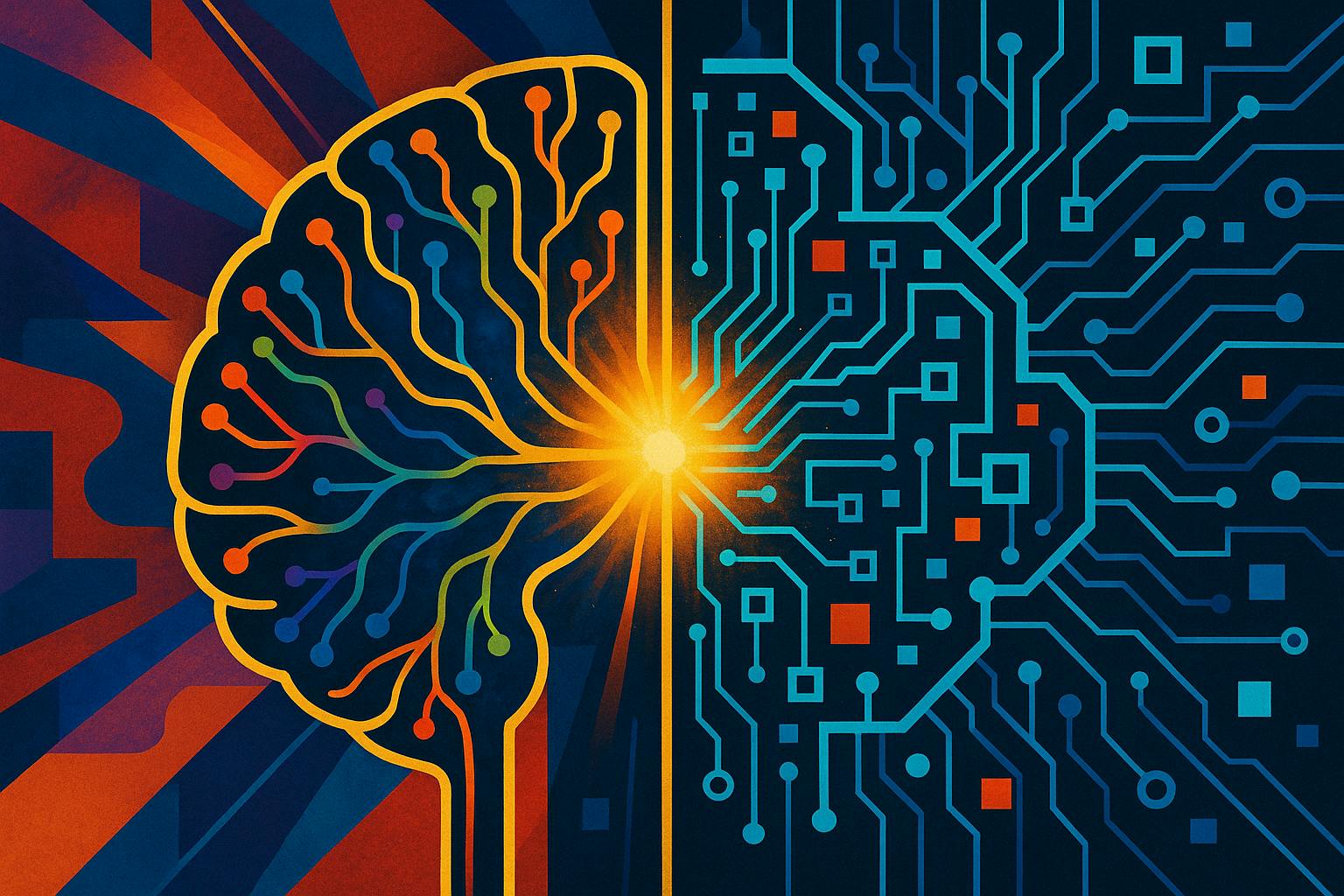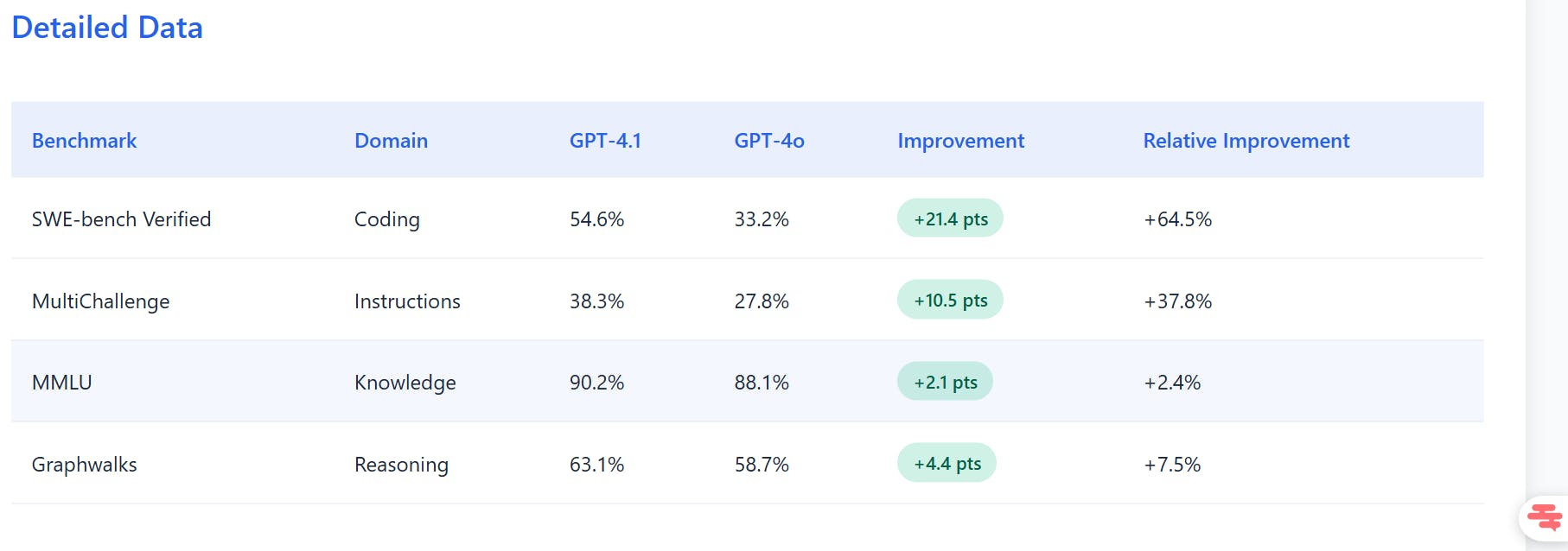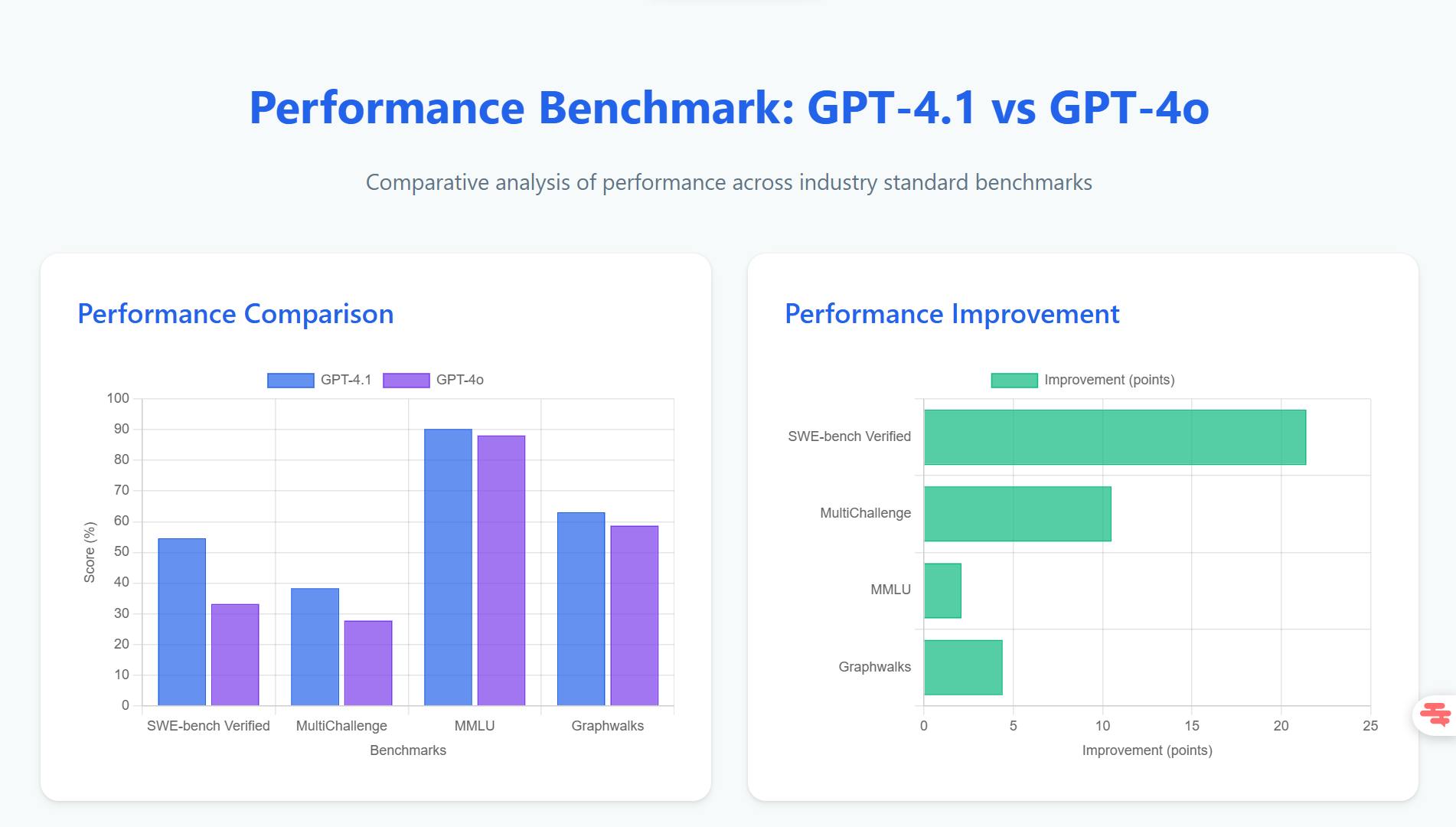
Jul 23, 2025
Table of contents :
Discover the major innovations of GPT-4.1, OpenAI's new model that is transforming artificial intelligence with its one million token context, exceptional performance and reduced costs.
On April 14, 2025, OpenAI unveiled GPT-4.1, its new generation of artificial intelligence models that represents much more than a simple incremental update. This major evolution is part of a continuous innovation strategy aimed at pushing technological boundaries while democratizing access to advanced AI. Unlike previous iterations, GPT-4.1 redefines the balance between power, accessibility, and cost of use.
OpenAI now offers a complete family of models with three distinct variants, each designed to meet specific needs:
GPT-4.1: The flagship of the range, optimized for complex tasks requiring deep understanding and elaborate reasoning. It particularly excels in advanced coding and the analysis of voluminous technical documents.
GPT-4.1 mini: Intermediate version offering an excellent balance between performance and cost. A surprise of the launch, this model even outperforms the standard version on certain visual benchmarks, with an impressive score of 75% on MMMU (Massive Multimodal Understanding).
GPT-4.1 nano: The lightest and most economical version, ideal for applications requiring large-scale deployment or rapid responses. Despite its reduced size, it retains much of the reasoning capabilities of its bigger brothers.
This diversification strategy allows developers and businesses to precisely choose the model that corresponds to their needs and budget constraints.
GPT-4.1 follows a logical evolution after GPT-4o, but with a significant change in approach. Unlike previous versions, these new models are exclusively available via the API, and not directly in ChatGPT. This strategic decision reflects OpenAI's desire to segment its offering between the general public and professional developers.
This family of models is also gradually replacing GPT-4.5, which is scheduled to be discontinued in July 2025. This transition illustrates the acceleration of the innovation cycle at OpenAI, which no longer hesitates to remove recent models to encourage the adoption of more efficient and economical technologies.
The timing of this launch, in April 2025, is not coincidental. It comes in a context of increased competition with Google (Gemini 2.5 Pro) and Anthropic (Claude 3.7), both of which recently announced similar long context processing capabilities. This launch allows OpenAI to maintain its technological leadership while offering more aggressive pricing than its competitors.
The date also coincides with the rise of agentic and autonomous AI applications, which precisely require the advanced reasoning capabilities and extended context processing that GPT-4.1 offers.
The technical advances of GPT-4.1 redefine what can be expected from a generative AI model in 2025. The improvements are not limited to abstract metrics but translate into concrete capabilities that transform the user experience.
The most impressive capability of GPT-4.1 is undoubtedly its extended context processing of up to 1 million tokens in input, equivalent to approximately 750,000 words or 3,000 pages of text. This technical feat is based on an optimized attention architecture that considerably reduces the computational complexity usually associated with long contexts.
For users, this concretely means the possibility to analyze:
The model maintains its coherence and relevance even on these massive volumes of data, which was previously impossible without manual fragmentation of content. This advance eliminates a major constraint that limited the adoption of AI in certain sectors.
GPT-4.1 also takes a decisive step in multimodal processing, particularly for video understanding. With a score of 72% on Video-MME, the model can now analyze videos of 30 to 60 minutes without subtitles, understand their content, and answer complex questions about the events, relationships, and concepts presented.
This capability opens up revolutionary possibilities for:
The GPT-4.1 mini model is particularly distinguished in visual tasks, even surpassing GPT-4o on image benchmarks with a success rate of 75% on MMMU, demonstrating the effectiveness of the optimizations made to the visual perception layers.
The performance of GPT-4.1 translates into measurable improvements on industry standard benchmarks:

These improvements are particularly impressive in the field of coding, where GPT-4.1 establishes a new standard with a progression of more than 21 points on SWE-bench Verified. The model approaches the performance of Gemini 2.5 Pro (63.8%) while offering better precision in executing complex instructions.

While GPT-4.1 improves performance across all tasks, it particularly excels in the field of software development, to the point of radically transforming coding practices.
The excellence of GPT-4.1 in programming is based on several targeted technical advances:
Improved structural understanding: The model better grasps the overall architecture of software projects and the relationships between components, thanks to its extended context window.
Generation of compilable code: GPT-4.1 produces code that compiles on the first attempt in 82% of cases, compared to 67% for GPT-4o, considerably reducing debugging time.
Respect for specific formats: The model perfectly masters technical formats such as diffs, SQL schemas, or Kubernetes configurations, with a syntactic precision of 94%.
Understanding of best practices: GPT-4.1 natively integrates SOLID principles, design patterns, and modern security standards in its suggestions.
These improvements allow the model to handle complex development tasks that previously required significant human expertise.
The integration of GPT-4.1 with GitHub Copilot represents a major advance for developers. Available in public preview from launch, this integration allows:
Microsoft has also announced the integration of GPT-4.1 into Visual Studio and Azure DevOps, creating a complete development assistance ecosystem that covers the entire software lifecycle.
The first feedback from developers with access to GPT-4.1 reveals particularly impressive use cases:
Large-scale refactoring: A developer reported having migrated an application from React 16 to React 18 in one day instead of the estimated two weeks, thanks to GPT-4.1's complete analysis of the codebase.
Complex debugging: The ability to simultaneously analyze error logs, source code, and documentation allows the identification of subtle bugs that previous versions could not detect.
Creation of coherent APIs: GPT-4.1 can design complete API architectures respecting REST or GraphQL principles, with automatically generated OpenAPI documentation.
Accelerated training: Junior developers use the model to quickly understand complex codebases, significantly reducing their integration time.
These concrete examples illustrate how GPT-4.1 transforms not only individual productivity but also collaborative practices in software development.
The major innovation in pricing is the introduction of a prompt caching system with a 75% discount. Concretely, when a similar prompt is submitted multiple times (for example, to process different documents with the same instructions), only the first call is charged at the full rate.
This feature allows considerable savings in scenarios such as:
For businesses, this means that increasing the volume of use no longer leads to a linear growth in costs, making large-scale adoption economically viable.
Beyond technical specifications and economic considerations, GPT-4.1 concretely transforms the daily operations of businesses across many sectors.
Several sectors stand out as immediate beneficiaries of GPT-4.1's capabilities:
Legal services: The ability to analyze entire contracts, case law, and legal documentation allows for the automation of legal research and due diligence. An international law firm reported a 73% reduction in time spent on contract analysis.
Healthcare and medical research: The analysis of complete medical records and extensive scientific literature accelerates diagnosis and research. A university hospital uses GPT-4.1 to identify patterns in thousands of records of patients with rare diseases.
Financial services: The analysis of financial reports, earnings call transcripts, and market data allows for more precise insights. An asset management company has developed a sentiment analysis system that processes all corporate communications for 500 listed companies.
Education: The creation of personalized learning paths based on in-depth analysis of student performance and preferences. An EdTech platform uses GPT-4.1 to generate explanations adapted to the exact level of understanding of each learner.
These examples demonstrate that GPT-4.1 is not simply a productivity tool, but a true transformer of business processes.
The long context processing capability fundamentally transforms certain business processes:
Document analysis: Legal and compliance departments can now analyze complete sets of documents rather than fragments, eliminating the risk of missing critical information at intersections.
Advanced customer service: Assistance systems can access the complete history of customer interactions and all product documentation, offering unprecedented contextual support.
Research and development: R&D teams can query entire scientific corpora and obtain syntheses that preserve the nuances and interconnections between concepts.
Complex project management: The ability to ingest and analyze all documentation, progress reports, and communications of a project allows for more informed supervision and decision-making.
This transformation of processes is not limited to automation but also includes the augmentation of human capabilities, allowing professionals to focus on higher value-added tasks.
Early adopters of GPT-4.1 report concrete results:
"GPT-4.1 has reduced our product development cycle by 40%. The ability to simultaneously analyze technical specifications, user feedback, and regulatory constraints allows us to identify innovation opportunities that we would have missed." - Innovation Director, manufacturing company
"We use GPT-4.1 nano to analyze every customer interaction in real-time. Despite its reduced cost, it identifies emerging problems and cross-selling opportunities with remarkable precision." - CX Manager, telecommunications company
"The multimodal understanding of GPT-4.1 allows us to automatically extract insights from our client meeting recordings. It's like having a business analyst attending every conversation." - VP Sales, consulting firm
These testimonials confirm that GPT-4.1 is not simply an incremental improvement, but a technology that redefines the possibilities of AI in business, with measurable impacts on business results.
GPT-4.1 represents much more than a simple technical update. By combining extended context processing, advanced multimodal capabilities, and accessible pricing, OpenAI redefines what businesses can expect from generative AI. Early feedback already demonstrates its transformative impact on productivity, innovation, and decision-making in many sectors.
As adoption accelerates, the question is no longer whether GPT-4.1 will transform your field of activity, but how you can strategically integrate it to maintain your competitive advantage in an ecosystem where augmented intelligence is rapidly becoming the norm.
author
OSNI

Published
April 15, 2025